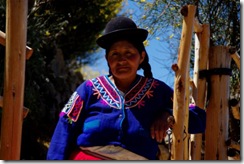On Thursday, our trio continued as we travelled around Lake Titikaka by bus and, after 90-minutes, we crossed the border from Peru into Bolivia near the town of Copacobana. (Not the Brazilian city by th same name, where you could expect to find Barry Manilow).
At the border, we all had to get out of the bus and file into a little shop front in which was the office of the Peruvian customs. Then it was a visit next door to the immigration office where we had passports stamped. I think we have more stamps in our passport from this trip than our last three trips combined. After that, we walked 100 metres up a hill and under an arch which denoted the actual location of the border and then a repeat of the same steps in Bolivia.
Bolivia is the third poorest country in South America, after Nicaragua and Haiti. Strangely enough, it has the largest reserves of natural gas on the continent, the largest`deposits of tin and lithium. So you ask, where does the money go? Who knows – I never found out either. It is currently the only country in the world with an Indian president. There are some nine million people living here. Sixty percent of the country is covered by Amazon rain forest. Bolivia owns 40% of Lake Titikaka and has a land locked navy based at Copocabana. It was quite strange to see sailors in the middle of nowhere and naval police patrolling the streets in a sitting down fashion. Weird!
We stopped to look at the basilica in the town. Apart from women wearing bowler hats, this was the only thing to see in town. The original Spanish fashion was to wear long dresses with hoops, but these were impracticable in this area. Instead the women wear five or six petticoats under their skirts and use the style of their skirt to signal their marital status. When the British came to work on the railways, they wore bowler hats and the women decided to adopt them as a fashion statement. They wear them perched on the top of their head without pins every now and then shake their head a little to- wobble their hat back into place. The women here are very shy and you have to be a bit sneaky and subtle to take their photo.
From Copocabana, we travelled across Lake Titikaka by hydrofoil, having a nice lunch on the way. We stopped at one of two large islands- to visit a museum and see the views. In typical Inca fashion, the large island was called ‘Sun Island’ and the smaller one, ‘Moon Island’. The Incas had a strong level of reverence for the sun and a lesser level for the2 moon. Both featured in different calendars and festivals were held at different times for each one.
On Sun Island, we walked up a steep set of steps to a view that was literally breath taking. At 3,800 metres (a little over 12,000 feet) it was hard to catch our breath and everyone was puffing for a few minutes trying to suck in enough oxygen to replace that which had been used on the climb.
A local farmer had some animals and we were able to see the difference between the various type of cameloids in South America.
The Llama has a long neck and its tail droops down. It has a face more like a kangaroo and can be domesticated.It’s primary use is for transport
The Alpaca has a stubbier face and holds its tail up. Its wool is prized for it soft texture – especially the wool from baby animals.
The Vicuna is a rare species that has a slim, delicate neck and is reddish brown like a red kangaroo. It can only be shorn once every three years and a scarf made from Vicuna wool can cost over US$700. They had one at this farm, and it was the only one that we got to see on our entire trip.
The final species is the Guanacco (pronounced One-acko). These cannot be tamed and are extremely territorial. They aee not found in this –area, but I saw lots of them in the wild on my previous trip to Patagonia.
A museum at the top of the hill showed a lineage of- the tribes and ethnic groups of this region. It had a terrific display of costumes of each period and which are still used in local carnivals.
After a longish 15 hour day, we arrived at the port of Chau and then travelled the last 80 kilometres by bus into La Paz. The traffic- for the last five kilometres was horrendous and it took a long time before we finally reached our hotel. All we wanted by then was a quick meal and off to bed.










Thought of requesting a vicuna scarf until I saw the price tag!
You’ve certainly had your heads in the clouds.